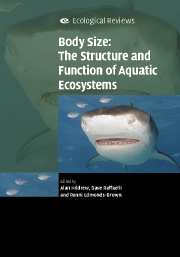Book contents
- Frontmatter
- Contents
- List of contributors
- Preface
- 1 The metabolic theory of ecology and the role of body size in marine and freshwater ecosystems
- 2 Body size and suspension feeding
- 3 Life histories and body size
- 4 Relationship between biomass turnover and body size for stream communities
- 5 Body size in streams: macroinvertebrate community size composition along natural and human-induced environmental gradients
- 6 Body size and predatory interactions in freshwaters: scaling from individuals to communities
- 7 Body size and trophic cascades in lakes
- 8 Body size and scale invariance: multifractals in invertebrate communities
- 9 Body size and biogeography
- 10 By wind, wings or water: body size, dispersal and range size in aquatic invertebrates
- 11 Body size and diversity in marine systems
- 12 Interplay between individual growth and population feedbacks shapes body-size distributions
- 13 The consequences of body size in model microbial ecosystems
- 14 Body size, exploitation and conservation of marine organisms
- 15 How body size mediates the role of animals in nutrient cycling in aquatic ecosystems
- 16 Body sizes in food chains of animal predators and parasites
- 17 Body size in aquatic ecology: important, but not the whole story
- Index
- References
6 - Body size and predatory interactions in freshwaters: scaling from individuals to communities
Published online by Cambridge University Press: 02 December 2009
- Frontmatter
- Contents
- List of contributors
- Preface
- 1 The metabolic theory of ecology and the role of body size in marine and freshwater ecosystems
- 2 Body size and suspension feeding
- 3 Life histories and body size
- 4 Relationship between biomass turnover and body size for stream communities
- 5 Body size in streams: macroinvertebrate community size composition along natural and human-induced environmental gradients
- 6 Body size and predatory interactions in freshwaters: scaling from individuals to communities
- 7 Body size and trophic cascades in lakes
- 8 Body size and scale invariance: multifractals in invertebrate communities
- 9 Body size and biogeography
- 10 By wind, wings or water: body size, dispersal and range size in aquatic invertebrates
- 11 Body size and diversity in marine systems
- 12 Interplay between individual growth and population feedbacks shapes body-size distributions
- 13 The consequences of body size in model microbial ecosystems
- 14 Body size, exploitation and conservation of marine organisms
- 15 How body size mediates the role of animals in nutrient cycling in aquatic ecosystems
- 16 Body sizes in food chains of animal predators and parasites
- 17 Body size in aquatic ecology: important, but not the whole story
- Index
- References
Summary
Introduction
Body size is an attribute of individual organisms. It affects, or at least is correlated with, a considerable array of physical, physiological and behavioural characteristics that determine where individuals occur and what they do (Elton, 1927; Peters, 1983; Brown et al., 2004; Woodward, Speirs & Hildrew, 2005c). Such ubiquity makes body size an obvious candidate source of general rules that can be derived from selective processes acting on individuals, but which can also be applied at higher levels of ecological organization (Cousins, 1980; Peters, 1983; Dickie, Kerr & Boudreau, 1987; Yodzis & Innes, 1992; Cohen et al., 1993; Gaston & Blackburn, 2000; Cohen, Jonsson & Carpenter, 2003; Emmerson & Raffaelli, 2004). Although body size was identified as a key link between natural history aspects of population dynamics and community structure many decades ago (e.g. Hardy, 1924; Elton, 1927; Hutchinson, 1959), these early ideas have languished somewhat until relatively recently. In the last two to three decades a plethora of allometric body-size scaling relationships have been described and used to derive mechanisms to explain, or parameters to model, general patterns in natural systems (e.g. Peters, 1983). Recently, it has been suggested that basal metabolic rate is the fundamental constraint that underpins many of the size-related patterns and processes observed in natural systems, and that a metabolic theory of ecology could, eventually, attain similar importance to that of the genetic theory of evolutionary biology (Brown et al., 2004; Brown, Allen & Gillooly, this volume).
- Type
- Chapter
- Information
- Body Size: The Structure and Function of Aquatic Ecosystems , pp. 98 - 117Publisher: Cambridge University PressPrint publication year: 2007
References
- 63
- Cited by

